Rudy
Admin
This is the continuation to "Where was Rudy Part Trois" found here.
After a short drive from the Standing Stones of Stenness, we arrived at The Ring of Brodgar,
another Neolithic henge on the Main (largest) island of Orkney, Scotland.
Most henges do not contain stone circles; Brodgar is a striking exception, ranking with Avebury
(and to a lesser extent Stonehenge) among the greatest of such sites.
Unlike similar structures such as Avebury, there are no obvious stones inside the circle,
but since the interior of the circle has never been excavated by archaeologists, the possibility
remains that wooden structures, for example, may have been present. The monument's age
remains uncertain. It is generally thought to have been erected between 2500 BC and 2000 BC,
and was, therefore, the last of the great Neolithic monuments built on the Ness.
The stone circle is 341 ft in diameter, and the third largest in the British Isles.
The ring originally comprised up to 60 stones, of which only 27 remained
standing at the end of the 20th century.
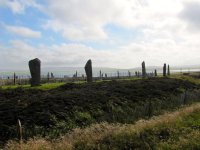
After another short drive we arrived at Skara Brae, a stone-built Neolithic
settlement. We are talking stone age here folks.
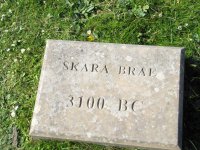
Consisting of eight clustered houses, it was occupied from roughly 3180 BC
to about 2500 BC.
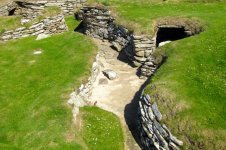
In the winter of 1850, a severe storm hit Scotland, causing widespread damage.
In the Bay of Skaill, the storm stripped the earth from a large irregular knoll
known as "Skerrabra". When the storm cleared, local villagers found the outline
of a village, consisting of a number of small houses without roofs.
William Watt of Skaill, the local laird, began an amateur excavation of the site,
but after four houses were uncovered, the work was abandoned in 1868.
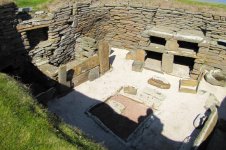
Skara Brae's people were makers and users of grooved ware, a distinctive style
of pottery that appeared in northern Scotland not long before the establishment
of the village. The houses used earth sheltering, being sunk into the ground.
They were sunk into mounds of pre-existing prehistoric domestic waste known
as middens. The midden provided the houses with a stability and also acted as
insulation against Orkney's harsh winter climate. On average, each house
measures 430 sq ft in size with a large square room containing a stone hearth used for heating and cooking. Given the number of homes, it seems likely that no more than fifty people lived in Skara Brae at any given time.
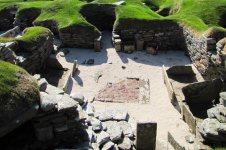
The dwellings contain a number of stone-built pieces of furniture, including
cupboards, dressers, seats, and storage boxes. Each dwelling was entered
through a low doorway that had a stone slab door that could be closed "by a bar
that slid in bar-holes cut in the stone door jambs". A sophisticated drainage
system was incorporated into the village's design. It included a primitive form of
toilet in each dwelling. These stone age folks were pretty sophisticated.
A bit of trivia: The site provided the earliest known record of the human flea
Pulex irritans in Europe.
Hope you are enjoying this series. Shortly, I will post my next hint as to my whereabouts.
After a short drive from the Standing Stones of Stenness, we arrived at The Ring of Brodgar,
another Neolithic henge on the Main (largest) island of Orkney, Scotland.
Most henges do not contain stone circles; Brodgar is a striking exception, ranking with Avebury
(and to a lesser extent Stonehenge) among the greatest of such sites.
Unlike similar structures such as Avebury, there are no obvious stones inside the circle,
but since the interior of the circle has never been excavated by archaeologists, the possibility
remains that wooden structures, for example, may have been present. The monument's age
remains uncertain. It is generally thought to have been erected between 2500 BC and 2000 BC,
and was, therefore, the last of the great Neolithic monuments built on the Ness.
The stone circle is 341 ft in diameter, and the third largest in the British Isles.
The ring originally comprised up to 60 stones, of which only 27 remained
standing at the end of the 20th century.

After another short drive we arrived at Skara Brae, a stone-built Neolithic
settlement. We are talking stone age here folks.

Consisting of eight clustered houses, it was occupied from roughly 3180 BC
to about 2500 BC.


In the winter of 1850, a severe storm hit Scotland, causing widespread damage.
In the Bay of Skaill, the storm stripped the earth from a large irregular knoll
known as "Skerrabra". When the storm cleared, local villagers found the outline
of a village, consisting of a number of small houses without roofs.
William Watt of Skaill, the local laird, began an amateur excavation of the site,
but after four houses were uncovered, the work was abandoned in 1868.

Skara Brae's people were makers and users of grooved ware, a distinctive style
of pottery that appeared in northern Scotland not long before the establishment
of the village. The houses used earth sheltering, being sunk into the ground.
They were sunk into mounds of pre-existing prehistoric domestic waste known
as middens. The midden provided the houses with a stability and also acted as
insulation against Orkney's harsh winter climate. On average, each house
measures 430 sq ft in size with a large square room containing a stone hearth used for heating and cooking. Given the number of homes, it seems likely that no more than fifty people lived in Skara Brae at any given time.

The dwellings contain a number of stone-built pieces of furniture, including
cupboards, dressers, seats, and storage boxes. Each dwelling was entered
through a low doorway that had a stone slab door that could be closed "by a bar
that slid in bar-holes cut in the stone door jambs". A sophisticated drainage
system was incorporated into the village's design. It included a primitive form of
toilet in each dwelling. These stone age folks were pretty sophisticated.
A bit of trivia: The site provided the earliest known record of the human flea
Pulex irritans in Europe.

Hope you are enjoying this series. Shortly, I will post my next hint as to my whereabouts.



